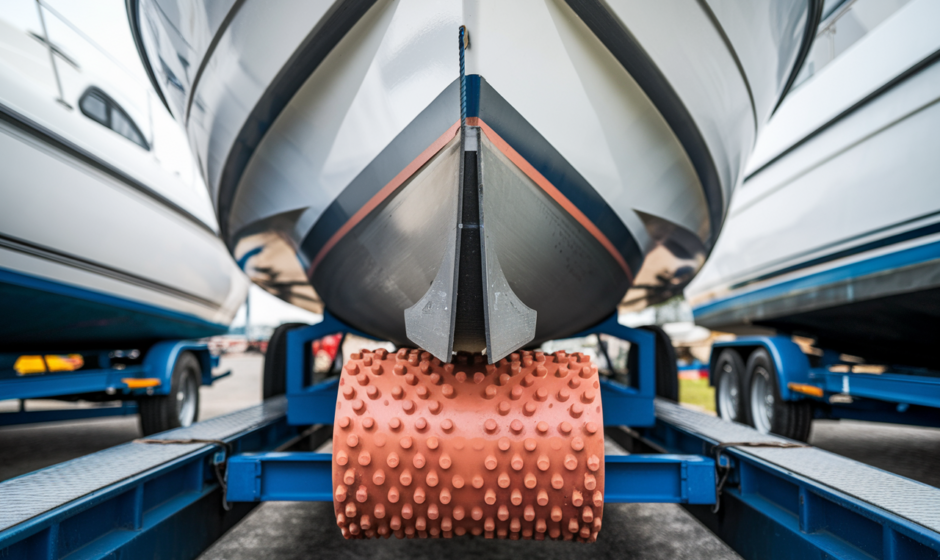Rubber Keel Rollers are essential trailer accessories designed to provide support, cushioning, and stability to boats during transportation. When it comes to moving a boat from one location to another, a trailer is the most efficient and reliable solution. However, the trailer itself needs the right components to ensure the boat’s safety. One of the most crucial elements in this setup is the keel roller. In this blog post, we will explore the significance of rubber keel rollers, their benefits, how to choose the right one, and why they are an indispensable part of your boat trailer accessories.
What Are Rubber Keel Rollers?
A rubber keel roller is a cylindrical part of a boat trailer that helps support the keel, the lowest part of a boat’s hull. The keel serves as the boat’s backbone, so it’s vital to protect it from damage during transport. The rollers are mounted along the trailer’s centerline, allowing the boat to glide smoothly on and off the trailer. This minimizes the risk of scrapes and scratches that could harm the boat’s structure or affect its performance.
Rubber is the material of choice for these rollers due to its durability, flexibility, and cushioning properties. Unlike hard plastic or metal rollers, rubber provides a softer, more forgiving surface that absorbs shocks, reducing the chances of damage to both the boat and the trailer. This makes rubber keel rollers an excellent investment for any boat owner looking to maintain their vessel’s integrity during transit.
The Role of Rubber Keel Rollers in Trailer Accessories
When it comes to trailer accessories, rubber keel rollers are at the top of the list for ensuring the smooth and safe transportation of boats. Their role goes beyond merely supporting the keel; they contribute to the overall ease of loading and unloading the boat. This makes the entire process quicker, safer, and more efficient.
For instance, when a boat is being launched or retrieved from the water, the keel rollers make contact with the hull and guide it onto the trailer without excessive friction. The softness of the rubber helps protect the hull from scratches and dings that can occur with harder materials. Additionally, the flexibility of rubber enables the rollers to conform slightly to the shape of the keel, providing a custom fit and better support.
In the broader context of trailer accessories, keel rollers are part of a system that includes winches, guide-ons, and bunk boards. Each component plays a role in ensuring that the boat is securely held in place during transportation. However, the rubber keel rollers specifically focus on protecting the most sensitive part of the hull, which is crucial for maintaining the boat’s stability and performance.
Benefits of Using Rubber Keel Rollers
There are several benefits to using rubber keel rollers as part of your trailer accessories. These advantages make them a preferred choice for many boat owners and trailer manufacturers.
Enhanced Durability and Longevity
Rubber is an extremely durable material, capable of withstanding harsh weather conditions and exposure to saltwater. Unlike plastic rollers that may crack under pressure or extreme temperatures, rubber remains flexible and resilient. This durability ensures that the rubber keel rollers will last for many years, providing consistent performance with minimal maintenance.
Superior Shock Absorption
One of the standout features of rubber is its ability to absorb shock. When you’re towing a boat, especially over rough terrain or bumpy roads, the rollers help cushion the impact, protecting both the trailer and the boat. This shock absorption minimizes the risk of structural damage to the hull, which is critical for maintaining the boat’s longevity and seaworthiness.
Reduced Friction and Damage
Rubber keel rollers provide a smoother surface for the keel to rest on, reducing friction as the boat is loaded or unloaded. This is particularly important for boats with delicate or freshly painted hulls, as it helps prevent scratches and scuffs. The reduced friction also makes it easier to move the boat on and off the trailer, saving time and effort during the process.
Improved Stability and Alignment
These rollers help keep the boat centered on the trailer, providing stability during transit. By aligning the boat correctly, rubber keel rollers prevent swaying and shifting, which can be dangerous while driving. Proper alignment also makes launching and retrieving the boat much simpler, as it reduces the need for adjustments.
Choosing the Right Rubber Keel Rollers for Your Trailer
When selecting rubber keel rollers for your boat trailer, there are several factors to consider to ensure you get the right fit and performance. Not all keel rollers are the same, and choosing the wrong one could lead to inadequate support and potential damage to your boat.
Size and Diameter
The size of the roller is a critical factor. It needs to match the dimensions of your boat and trailer. If the roller is too small, it may not provide sufficient support, while an oversized roller could make loading and unloading more challenging. The diameter of the roller affects how easily the boat rolls on and off the trailer. Larger diameters generally provide better support and a smoother rolling action.
Material Quality
While all rubber keel rollers are made of rubber, the quality of the rubber can vary. Look for high-quality, marine-grade rubber that is resistant to UV rays, saltwater, and chemicals. This ensures that the rollers will not degrade quickly and can withstand the harsh conditions of marine environments.
Compatibility with Trailer Setup
Ensure that the rollers are compatible with your trailer’s design and setup. Different trailers have varying mounting systems, so it’s important to choose rollers that can be easily installed on your specific model. Some trailers may require additional hardware or specific mounting brackets, so it’s worth checking these requirements before purchasing.
Installation and Maintenance Tips for Rubber Keel Rollers
Proper installation and maintenance of rubber keel rollers are crucial to maximize their effectiveness and lifespan. Incorrect installation can lead to uneven support and increased wear on the rollers and the keel itself.
Installing the Rollers
Begin by ensuring that the trailer is on a flat, stable surface. Remove the old rollers if they are being replaced, and inspect the mounting brackets for any signs of wear or damage. Install the new rubber keel rollers securely, making sure they rotate freely without wobbling. Tighten the mounting bolts to the recommended torque to prevent them from loosening during transit.
Regular Maintenance
Like all trailer accessories, rubber keel rollers require regular inspection and maintenance to keep them in top condition. Check the rollers for signs of wear, such as cracks, flat spots, or excessive hardness. Over time, exposure to sunlight and saltwater can degrade the rubber, so replace worn-out rollers promptly to avoid damaging the boat’s hull. Cleaning the rollers after each use with fresh water can help remove salt and debris, extending their lifespan.
Lubrication
While rubber keel rollers typically do not require lubrication, the mounting hardware may benefit from occasional greasing. This can help prevent rust and ensure smooth operation. Be sure to use a marine-grade lubricant that is safe for rubber to avoid damaging the material.
Common Issues with Rubber Keel Rollers and How to Fix Them
Even though rubber keel rollers are durable and long-lasting, they are not immune to issues. Here are some common problems and how to address them:
Roller Flattening
Over time, the weight of the boat can cause the rubber to flatten, especially if the trailer is stored with the boat loaded for extended periods. Flattened rollers can make loading and unloading more difficult and may lead to uneven support. If you notice flattening, consider replacing the rollers or using a support block when storing the boat on the trailer to reduce pressure.
Cracking or Splitting
Cracks in the rubber can occur due to UV exposure, age, or chemical damage. Cracked rollers should be replaced immediately to prevent damage to the boat’s keel. To avoid cracking, choose UV-resistant rollers and clean them regularly to remove harmful substances.
Roller Sticking
If the rollers are not rotating smoothly, it may be due to debris caught in the mounting brackets or a lack of lubrication. Cleaning the rollers and applying a suitable lubricant can help restore smooth operation. Regular inspection and maintenance can prevent this issue from occurring.
Why Rubber Keel Rollers Are Essential Trailer Accessories
In the world of trailer accessories, rubber keel rollers are a small but mighty component that plays a significant role in protecting your boat. They offer a cost-effective way to ensure that your boat is well-supported and safe during transit. By reducing friction, absorbing shock, and providing stability, these rollers make loading, unloading, and transporting your boat easier and safer.
Investing in high-quality rubber keel rollers is a smart move for any boat owner who values their vessel’s longevity and performance. Whether you have a small fishing boat or a larger recreational vessel, the right set of rollers can make a big difference in your boating experience.
Conclusion
In conclusion, rubber keel rollers are an indispensable part of your boat trailer’s setup. As essential trailer accessories, they provide the necessary support, cushioning, and alignment to ensure safe and smooth transportation of your boat. By choosing high-quality rubber rollers, installing them correctly, and maintaining them regularly, you can protect your boat’s hull from damage and enjoy hassle-free launching and retrieval every time.
If you are in the market for new trailer accessories, consider investing in durable, marine-grade rubber keel rollers. They are a small investment that can save you from costly repairs and extend the life of your boat. So the next time you prepare to hit the water, rest easy knowing your boat is well-supported by the best rubber keel rollers.
Visit celebrating chilaquiles for more joyful updates.



